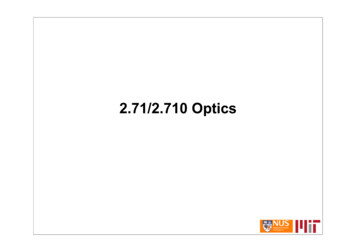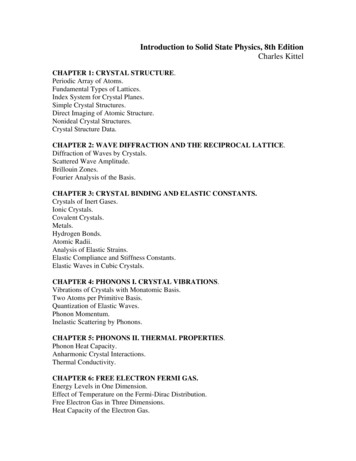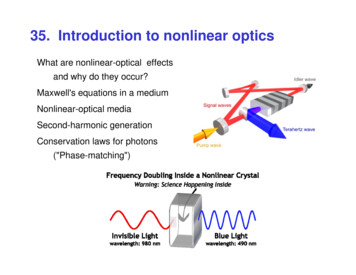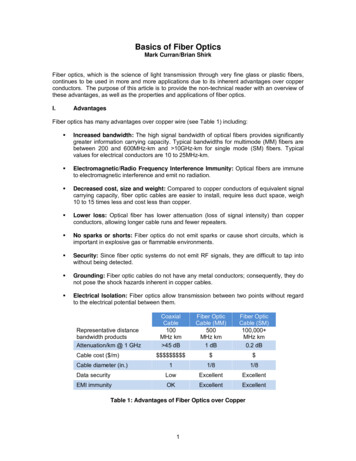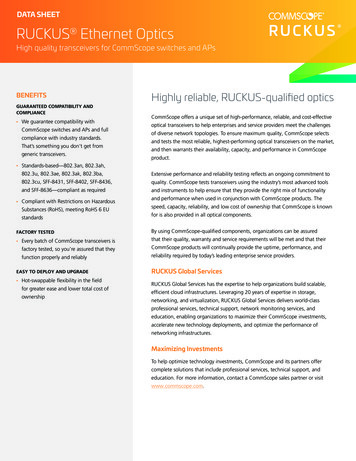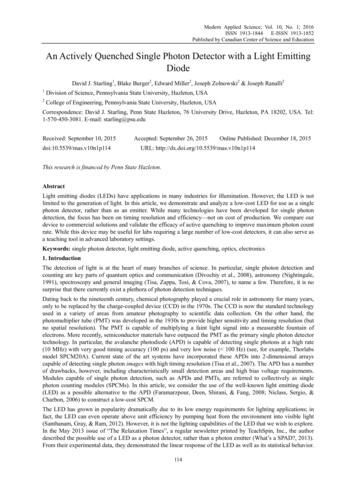
Transcription
Crystal Optics of Visible LightThis can be a very helpful aspect of minerals in understandingthe petrographic history of a rock. The manner by which lightis transferred through a mineral is a means to describe andquantify mineral properties in situ as well as to describe therelationships between minerals in a rock.The interaction and behavior of light within minerals is a keydiagnostic features that can be applied in multiple ways.
To study minerals in thin section we use a polarizing lightmicroscope or petrographic microscopeUsing a substage light source with a series of lenses, polarizer(s), andlight intensity adjustments we can examine the properties of a mineral
The path of light in a polarizingmicroscopeThe vernier graduated stage on apetrographic microscope can befreely rotated through 360 There are two condensers that canbe used to vary the diameter of thebeam of light interacting with thesample (helpful when using theBertrand Lens for viewinginterference figures)The substage diaphram is used foraltering the light intensity (mostuseful for viewing relief andobserving the Becke Line)
Refraction(only really useful for studying optically isotropic mediums) The speed of light in a vacuum is 3 x 108 m/sec When light passes from one materials to another of a differentdensity at an angle oblique to perpendicular the velocity of thatray of light must change the result is also a change in directionLight velocity in material A sin α Light velocity in material B sin β This is Snell’s Law: the propagation velocity of light in amedium A to its velocity in a denser medium B is equal to the ratioof the sines of the angle of incidence (α) at the interface and theangle of refraction (β) with B.
The Wave Theory of LightThis concept is based upon the electromagnetic spectrum and the400-700 nanometer energy range of visible light humans arecapable of seeingWave crestWavelength (λ)VibrationdirectionWavetroughElectric vectorsAmplitudePropagationdirection
Anisotropic mineralsThese are minerals cabable of polarzing into two light raysvibrating perpendicular to each other (double refraction).Anisotropic minerals are unique in that they can be rotated sothat polarizing light is unaffected by the double refraction of theanisotropic mineralsAnisotropic minerals will extinguish four times during a 360 ofrotation in cross-polarized light
In anisotropic minerals there is a difference in the rate at whichlight travels depending on the size of the refractive index-n: direction of the smaller refractive index light movesquickly in this direction-N: direction of the larger refractive index light movesmore slowly in this directionThe relationship between N and n leads to the concepts ofbirefringence and retardation
From crystal systems to optical classes-Based on the axial relationships of our 6 crystal systems, we areable to create three distinct optical groups (2 of which are furthersubdivided)-The classes are identified by a surface that is related to the speed oflight through a particular crystal, the length of which is proportionalto the refractive index (n)velocity of light in a vacuumn velocity of light in a material-Velocity of a light wave is determined by the electron density in amaterial as well as the distribution of the density – the result is thatcharge distribution has a major affect on the way light is transmittedthrough a particular medium
-Refractive indices are quite useful in identifying mineralsversus liquids of a know index or relative to one another-With a petrographic microscope, this is done using theBeck e Line test :1) Focus a medium to high power on the grainboundaries of the mineral of interest2) Slowly de-focus the view by lowering the stage3) The grain boundaries will move into the mediumwith the higher with the higher refractive index
-The optical relief (or relative height of a mineral) is also asemi-quantitative observational tool that can be used todescribe the difference between the refractive indices oftwo materials-Materials with a large difference in n are “high relief”versus materials with very similar n values that are “lowrelief”
Polarising materials .PolaroidGlassMinerals (tourmaline)When two pieces of the polarizing medium are combined placed oneupon the other with a 90 offset no light is transmitted.This is called Crossing the Polarisers
Isotropic Minerals (Cubic Minerals)When light enters a cubic (isotropic) mineral itsvibrational properties are unaffected.What does this mean?What does happen to the light?When light passes through such a mineral its vibrationdirection, produced by the polariser, is not changed.What does this mean when we viewsuch minerals in cross-polarised light?
Double RefractionA property of all anisotropic minerals, butspectacularly displayed in calcite.The calcite splits thepolarized the light intotwo perpendicularvectors.This can be prove with the assistance of a polariser.When the calcite rhomb is oriented in specificdirections relative to a polariser one or other of thelight-beams is absorbed. When the angle is obliqueboth spots are seen.
The difference between the largestand smallest possible refractiveindice values is called thebirefringence .The birefringence colour is what is recorded when ananisotropic mineral is viewed in crossed-polarised light.The interferenceorder is ameasure ofretardation(pathdifference).
CrystalSystemOpticalClassAxes# of xialε ω ( )ε ω (-)1Biaxialβ closer α( )β closer γ icAnisotropicUniaxial positiveUniaxial negativeBiaxial positiveBiaxial negative2-Optic axis: perpendicular to the circulardirection-Acute bisectrix (2V): angle less than 90 between 2 optic axes in biaxial minerals-Obtuse bisectrix: bisects the larger angle ina biaxial mineral
REVIEWRefractive indicesBecke lineReliefBirefringencePolarization of light
Geologists use polarising microscopes to study theinteraction between light and minerals of interest. When light passes between two mediums of differingrefractive index (density) its velocity changes (i.e. itsspeed and direction). Light moves away from the norm in lower RImaterials. When the angle of incidence passes a certain point alllight is reflected at the interface. Our microscopes polarise the light – we use light thatonly vibrates in one direction. Light entering isotropic minerals is unchanged. Light entering anisotropic minerals is split in two.
RetardationIf we look down a microscope with no thin sectionpresent, what is the colour of the light?What happens when the polarisers are crossed?What happens if we place a thin section of anisotropicminerals in the light’s path?
When monochromatic polarised light enters an anisotropicmineral it splits into perpendicular components (excludingthe special case): the two light beams are independent.The RI of a mineral varies as afunction of the crystallographicaxis. Therefore, the two beamsare created simultaneously butexit at different times.Therefore, the exitinglight consists of two lightbeams that are “out of phase”.
Constructive vs Destructive InterferenceConstructive waves – same lDouble the amplitude.Brighter light!Destructive waves.No light.Darkness!The intermediate situation results in light, but ofintermediate intensity (brightness).
What happens when the incident light is white?Depending on the RI and thickness of thecrystal the some light waves exiting thecrystal will interfere destructively, whileothers interfere constructively.When a colour wavelength is removed fromwhite light, we get coloured light.
In a case where the longer l are retarded ½ l,the resultant colour is dominated by blue/violet.The meaning of retard, isto hold back. So, in thiscase, the red light hasbeen held back ½ l.The difference in thenumber of l is the pathdifference or retardation.
The difference between the largestand smallest possible refractive indicevalues is called the birefringence.The birefringence colour is what is recorded when an anisotropicmineral is viewed in crossed-polarised light.The interferenceorder is a measureof retardation(path difference).
Other Consequences of Double RefractionColour and PleochroismIn plane polarised light, theeffects of double refraction isthat some minerals are coloured– the reason is similar, butslightly different from generalmineral colour (discussedpreviously).Tourmaline Acorn. Crystal thickensfrom top-to-bottom. Therefore, theretardation of doubly refracted lightincreases.
PleochroismFast yellowtransmitted.Plane polarised light is vibratingin one plane (E-W).When a mineral double diffractsthe light into a fast and a slowtravelling wave (perpendicularto one another) the orientationof the mineral controls theabsorption of the light.Fast yellowabsorbed.Slow greentransmitted.One vibration direction iscompletely absorbed in oneorientation, and the other whenthe mineral is rotated 90 .
Length Fast and Length SlowSign of elongationAs seen previously, the two light waves generated byanisotropic minerals have different velocities, controlled by therefractive index.These two vibration vectors may be referred to as the fast andthe slow – naturally!How does one determine which vibrationdirection is fast and which one is slow?
A Mineral withstraight extinction inXPlrs has maximumbirefringence at 45 The birefringence is caused by retardation.Note – there is not always pleochroism.By using an accessory plate the petrologist can artificially augment orhinder the retardation.The accessory plate is a wedge of mineralspecially cut such that its vibration directionsare known.Typically, they are length fast.
When the accessory plate augments the retardation (i.e. increases thepath difference) the order of birefringence colour increases.Slow on SlowSlow on FastWhen it reduces the pathdifference, the birefringencecolour decreases.
Crystal Optics of Visible Light. This can be a very helpful aspect of minerals in understanding the petrographic history of a rock. The manner by which light . charge distribution has a major affect on the way
